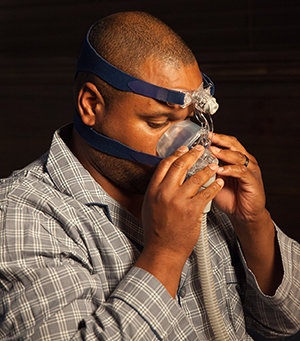Using a BiPAP
A BiPAP is a device that helps with breathing. BiPAP delivers an inhale pressure and an exhale pressure. It may be used when a health problem is making it hard for you to breathe.

The BiPAP machine
You should be familiar with the parts of your BiPAP machine. They include:
-
A facemask, nasal mask, or nasal plugs
-
The machine’s motor, which blows air into a tube
-
The tubing that connects the machine’s motor to the mask or plugs
Your BiPAP machine might also have other features, such as a heated humidifier.
Before you start BiPAP therapy, your machine may need to be calibrated. Someone from your healthcare team will adjust the settings. That person is often a respiratory therapist. The settings need to be correct so you receive the right therapy. You may also get other instructions on how to get ready for your BiPAP therapy.
When to use your BiPAP
You might get BiPAP therapy while at the hospital for a breathing emergency. You also might use it at home for an ongoing (chronic) condition. Follow your healthcare provider’s instructions about when to use your BiPAP. You might need to use it only while you sleep. Or you might need to use it all the time. Use it exactly as instructed. Otherwise you will not get the full benefits from your BiPAP therapy.
Getting used to your BiPAP
When you first start using BiPAP, you may feel uncomfortable. It may feel odd wearing a mask and feeling the flow of air. Over time, you should get used to it. If you feel like you really can’t breathe while using BiPAP, talk with your healthcare provider. They may need to adjust the pressure settings on your machine.
It’s important not to eat or drink anything while using BiPAP. You might inhale food or liquid into your lungs if you do so. Your healthcare provider may give you other instructions about the best way to use your machine.
If your health problem gets better, you may be able to start using less pressure on your BiPAP machine. Or you might be able to use the machine less often. Work with your healthcare team to help get the best treatment.
BiPAP settings
The BiPAP device settings are given as centimeters of water, or cm H2O. Each person’s pressure settings are different. Your healthcare provider will tell you what settings to use. Never change your BiPAP pressure setting unless your provider tells you to.
BiPAP ____________cm H20 pressure when you breathe in
BiPAP ____________cm H20 pressure when you breathe out
Fixing problems with your BiPAP
Talk with your healthcare team if you have any problems. They can help you address the issue.
-
Nasal dryness. A humidifier may help reduce nasal dryness.
-
Eye or sinus symptoms. Using a facemask instead of a nasal mask may also help reduce any eye or sinus symptoms.
-
Headaches. If you get headaches, they could be because of sinus congestion. In some cases, your healthcare provider might prescribe nasal saline or an antihistamine for these symptoms.
-
Leaky mask, skin irritation, or pressure lines. You may need a different size or type of mask. You may also find that adjusting the straps around your mask helps.
-
Stomach bloating. Your healthcare provider may be able to reduce the pressure setting on your machine to stop stomach bloating.
-
Noise. If the noise from the BiPAP bothers you, try using earplugs. If the device is very loud, check with the medical supplier to make sure it is working correctly.
Call 911
Have someone call 911if you have the following symptoms:
-
Problems breathing or unable to breathe
-
Feeling faint or becoming unresponsive
-
Skin or lips look blue, purple, or gray
-
Confusion
When to call your healthcare provider
Call your healthcare provider right away if any of these occur:
-
You feel like you can’t breathe while using your BiPAP
-
Your mask is constantly leaking air and you can’t make it fit
-
Severe or ongoing skin irritation from your mask
-
Stomach bloating
-
You are coughing or wheezing more
-
New symptoms or other symptoms that get worse